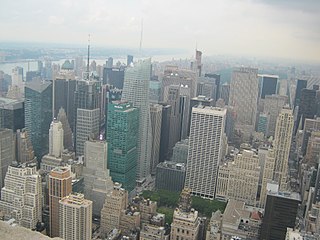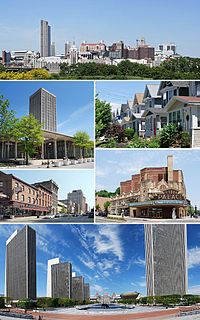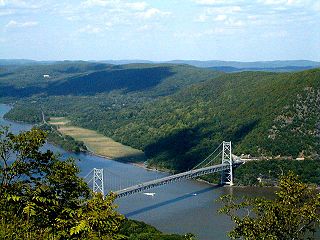Murals
The bridge has thirty concrete nine-foot obelisk-lampposts that feature trompe l'oeil still-life paintings by AlbanyMural Ltd . The Hudson River Way paintings were awarded the Americans for the Arts Public Art Network Award in 2004 for exceptional quality.

Concrete, usually Portland cement concrete, is a composite material composed of fine and coarse aggregate bonded together with a fluid cement that hardens over time—most frequently a lime-based cement binder, such as Portland cement, but sometimes with other hydraulic cements, such as a calcium aluminate cement. It is distinguished from other, non-cementitious types of concrete all binding some form of aggregate together, including asphalt concrete with a bitumen binder, which is frequently used for road surfaces, and polymer concretes that use polymers as a binder.
An obelisk is a tall, four-sided, narrow tapering monument which ends in a pyramid-like shape or pyramidion at the top. These were originally called tekhenu by their builders, the Ancient Egyptians. The Greeks who saw them used the Greek term 'obeliskos' to describe them, and this word passed into Latin and ultimately English. Ancient obelisks are monolithic; that is, they consist of a single stone. Most modern obelisks are made of several stones; some, like the Washington Monument, are buildings.
Sponsored by individuals and organizations, each mural depicts a historical period or event in Albany's history, from prehistoric times to the present. Many of the paintings are based on archaeological artifacts in area museums. Research for the composition of the paintings took 18 months and involved dozens of experts and historians from across the Capital District. The paintings themselves took two years to complete and were executed by principal artist Jan-Marie Spanard and assistant artist Koren Lazarou.
Human prehistory is the period between the use of the first stone tools c. 3.3 million years ago by hominins and the invention of writing systems. The earliest writing systems appeared c. 5,300 years ago, but it took thousands of years for writing to be widely adopted, and it was not used in some human cultures until the 19th century or even until the present. The end of prehistory therefore came at very different dates in different places, and the term is less often used in discussing societies where prehistory ended relatively recently.

Time is the indefinite continued progress of existence and events that occur in apparently irreversible succession from the past through the present to the future. Time is a component quantity of various measurements used to sequence events, to compare the duration of events or the intervals between them, and to quantify rates of change of quantities in material reality or in the conscious experience. Time is often referred to as a fourth dimension, along with three spatial dimensions.
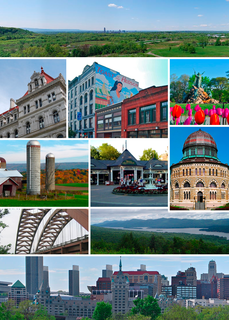
The Capital District, also known as the Capital Region, is the metropolitan area surrounding Albany, the capital of the U.S. state of New York. With a population of 1,170,483 (2013), the Capital District is the fourth largest metropolitan region in the state and the 45th largest in the country. Companies that have headquarters in Albany include CommerceHub and the Environment One Corporation. In the 21st century, the Capital District has emerged as a major anchor of Tech Valley, the moniker describing the technologically-focused region of eastern New York State. The Capital District was first settled by the Dutch in the early 17th century and came under English control in 1664. Albany has been the permanent capital of the state of New York since 1797. The Capital District is notable for many historical events that predate the independence of the United States, including the Albany Plan of Union and The Battles of Saratoga.
The paintings are made of a permanent pigment called potassium silicate. This same material has been used on exterior architecture in Western Europe since the mid-19th century and around the world in the past half-century. Very few American artists create paintings with potassium silicate mineral coatings, but these are the only pigments that can be applied to a stone or concrete substrate that will last indefinitely without fading or lifting from the surface. The Potassium silicate paints used on the Hudson River Way were produced by a German company called Keimfarben.

KEIMFARBEN GMBH is a medium-sized company based in Diedorf near Augsburg. It belongs to the Leonhard Moll AG Group and is one of the world's leading manufacturers of silicate paints. Buildings such as the White House, Mariyinsky Palace, Buckingham Palace, Sydney Opera House and the Bolshoi Theatre are painted with Keimfarben paints.
2018 - contrary to the views expressed above the murals have not lasted- the ones which remain are barely visible, others have been covered

Fresco is a technique of mural painting executed upon freshly laid, or wet lime plaster. Water is used as the vehicle for the dry-powder pigment to merge with the plaster, and with the setting of the plaster, the painting becomes an integral part of the wall. The word fresco is derived from the Italian adjective fresco meaning "fresh", and may thus be contrasted with fresco-secco or secco mural painting techniques, which are applied to dried plaster, to supplement painting in fresco. The fresco technique has been employed since antiquity and is closely associated with Italian Renaissance painting.

Cohoes is an incorporated city located in the northeast corner of Albany County in the U.S. state of New York. It is called the "Spindle City" because of the importance of textile manufacturing to its growth in the 19th century. The city's factories processed cotton from the Deep South, produced on plantations in the slave states.

New York State Route 2 (NY 2) is a state highway in the Capital District of New York in the United States. It extends for 30.89 miles (49.71 km) from an interchange with Interstate 87 (I-87) and NY 7 in the town of Colonie to the Massachusetts state line in Petersburgh, where it continues to Boston as Massachusetts Route 2. The route passes through the cities of Watervliet and Troy, where it connects to NY 32 and U.S. Route 4, respectively. In Grafton, located midway between Troy and Massachusetts, NY 2 serves Grafton Lakes State Park.

The Willis Avenue Bridge is a swing bridge that carries road traffic northbound over the Harlem River between the New York City boroughs of Manhattan and the Bronx, United States. It connects First Avenue in Manhattan with Willis Avenue in the Bronx. The New York City Department of Transportation is responsible for maintaining and operating the bridge.

The Patroon Island Bridge is a major crossing of the Hudson River in Albany, New York. The bridge carries Interstate 90, in the east-west direction, over the Hudson River between Albany and Rensselaer Counties.
Silicate mineral paints or mineral colors are paint coats with mineral binding agents. Two relevant mineral binders play a role in the field of colors: Lime and silicate.
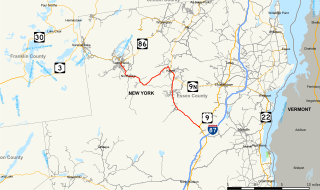
New York State Route 73 (NY 73) is a state highway located entirely within Essex County, New York, in the United States. The highway begins at an intersection with NY 86 in the village of Lake Placid and ends at a junction with U.S. Route 9 (US 9) north of the hamlet of Underwood in the extreme southwestern corner of the town of Elizabethtown. NY 73 meanders through a mountainous region of Adirondack Park and passes by several named peaks, including Porter Mountain and Lower Wolfjaw Mountain. Along the way, the route has a short concurrency with NY 9N in the town of Keene.

The Manhattan Waterfront Greenway is a foreshoreway for walking or cycling, 32 miles (51 km) long, around the island of Manhattan, in New York City. The largest portions are operated by the New York City Department of Parks and Recreation. It is separated from motor traffic, and many sections also separate pedestrians from cyclists. There are three principal parts — the East, Harlem and Hudson River Greenways.

The Palace Theatre is an entertainment venue in downtown Albany, New York, located on the corner of Clinton Avenue and North Pearl Street. The 2,844 seat theater is owned by the City of Albany and run by the Palace Performing Arts Center, Inc - a 501(c)(3) non-profit organization. The Palace Theatre hosts more than 150 events annually, from public performances such as concerts, plays, educational programs, live comedy and a classic movie series to private events such as weddings, dance competitions, corporate events and graduations. It is also the annual home of the Albany Symphony Orchestra.

The American Watercolor Society, founded in 1866, is a nonprofit membership organization devoted to the advancement of watercolor painting in the United States.

Painting is the practice of applying paint, pigment, color or other medium to a solid surface. The medium is commonly applied to the base with a brush, but other implements, such as knives, sponges, and airbrushes, can be used. The final work is also called a painting.

The Abrams Building was located at South Pearl Street and Hudson Avenue in Albany, New York, United States. It was a brick commercial building constructed in the 1880s. In 1980 it was listed on the National Register of Historic Places.

The Dequindre Cut is a below-grade pathway, formerly a Grand Trunk Western Railroad line, located on the east side of Detroit, Michigan, just west of St. Aubin Street. Much of the Cut has been converted to a greenway; the colorful graffiti along the pathway has been left in place.

Kingston is a city in and the county seat of Ulster County, New York, United States. It is 91 miles (146 km) north of New York City and 59 miles (95 km) south of Albany. The city's metropolitan area is grouped with the New York metropolitan area by the United States Census Bureau,
It became New York's first capital in 1777, and was burned by the British on October 13, 1777, after the Battles of Saratoga. In the 19th century, the city became an important transport hub after the discovery of natural cement in the region, and had both railroad and canal connections. Passenger rail service has since ceased, and many of the older buildings are part of three historic districts, including the Stockade District uptown, the Midtown Neighborhood Broadway Corridor, and the Rondout-West Strand Historic District downtown.

Eugene Field Park is a public park located along the North Branch of the Chicago River in the Albany Park neighborhood of Chicago. The park was platted, designed and constructed between 1923 and 1930, with the Clarence Hatzfeld-designed field house completed in 1930 under the auspices of the Albany Park District. The Chicago Park District was consolidated in 1934 and took over Eugene Field Park. The park has seen numerous changes and improvements over the years. Eugene Field park has tennis courts, athletic fields, a playground, two bridges and 60 foot tall light tower. Together, the park, and its historic features were listed on the National Register of Historic Places in 2006.
Keim's process is a technique of fresco preparation and painting intended to maximize the lifetime of the finished work. The process, as reported in 1884 at the Royal Society of Arts in London, was created by chemist and craftsman Adolf Wilhelm Keim of Munich, as an improvement on the earlier stereochromy technique of Schlotthaner and Johann Nepomuk von Fuchs.
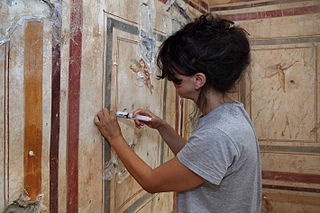
The conservation and restoration of frescoes is the process of caring for and maintaining frescos, and includes documentation, examination, research, and treatment to insure their long-term viability, when desired.

Albany Center Gallery is a nonprofit art space located in downtown Albany, New York. Supported by city, state, corporate and foundation funds, as well as fundraisers, individual donations and memberships, the Gallery is dedicated to the exhibition of regional artists within a 100-mile radius of Albany, and building a strong, knowledgeable audience for the visual arts. Serving the art community and the general public, all of Albany Center Gallery’s exhibitions, receptions, and artist interviews are free and open to the public. The gallery presents at least seven major exhibitions a year in the main gallery, including the Mohawk Hudson Regional Invitational, an annual exhibition featuring selected artists from the previous year’s Artists of the Mohawk-Hudson Region exhibit.


